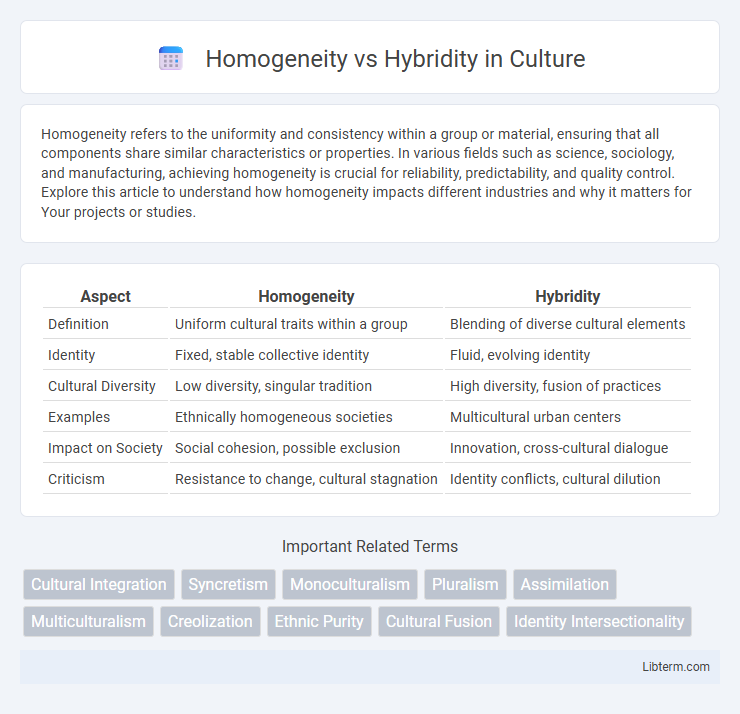Homogeneity refers to the uniformity and consistency within a group or material, ensuring that all components share similar characteristics or properties. In various fields such as science, sociology, and manufacturing, achieving homogeneity is crucial for reliability, predictability, and quality control. Explore this article to understand how homogeneity impacts different industries and why it matters for Your projects or studies.
Table of Comparison
| Aspect | Homogeneity | Hybridity |
|---|---|---|
| Definition | Uniform cultural traits within a group | Blending of diverse cultural elements |
| Identity | Fixed, stable collective identity | Fluid, evolving identity |
| Cultural Diversity | Low diversity, singular tradition | High diversity, fusion of practices |
| Examples | Ethnically homogeneous societies | Multicultural urban centers |
| Impact on Society | Social cohesion, possible exclusion | Innovation, cross-cultural dialogue |
| Criticism | Resistance to change, cultural stagnation | Identity conflicts, cultural dilution |
Understanding Homogeneity: Definition and Characteristics
Homogeneity refers to the quality of being uniform or consistent in composition, structure, or characteristics across a group or system. It is defined by shared traits, values, or behaviors that create unity and predictability within a population, avoiding diversity and variation. Key characteristics include cultural sameness, standardized practices, and the absence of internal differentiation, facilitating easier analysis and cohesion.
Hybridity Explained: Meaning and Importance
Hybridity refers to the blending of diverse cultural, social, or biological elements to create new, dynamic identities and systems that resist rigid categorization. This concept emphasizes the fluidity and interconnectedness of cultures, highlighting how hybrid forms foster innovation, adaptability, and inclusivity in multicultural societies. Understanding hybridity is crucial for addressing contemporary global challenges by promoting cross-cultural dialogue and reducing cultural homogenization.
Historical Context: Origins of Homogeneity and Hybridity
The concept of homogeneity emerged from early nationalist movements in the 19th century, emphasizing cultural and ethnic uniformity to solidify state identity and social cohesion. Hybridity traces its origins to colonial encounters and postcolonial theory in the mid-20th century, highlighting the blending of diverse cultures, languages, and identities resulting from migration, trade, and empire. Historical colonialism and globalization intensified cultural exchanges, challenging rigid notions of pure or homogeneous identities.
Cultural Perspectives: Embracing Similarity or Diversity
Cultural perspectives on homogeneity emphasize shared traditions, values, and collective identity that foster social cohesion and unity within a group. Hybridity highlights the blending of diverse cultural elements, promoting innovation, adaptability, and enriched social experiences through multicultural interactions. Embracing diversity through hybridity challenges the limitations of homogeneity by encouraging inclusive narratives and dynamic cultural evolution.
Homogeneity in Society: Advantages and Challenges
Homogeneity in society fosters social cohesion by promoting shared values, cultural norms, and a strong sense of identity, which can simplify communication and reduce conflict. Economies with homogeneous populations often benefit from streamlined policymaking and efficient resource allocation due to aligned interests and priorities. However, homogeneity may limit innovation and adaptability by reducing exposure to diverse perspectives and can lead to exclusion or marginalization of minority groups within the society.
The Benefits of Hybridity in a Globalized World
Hybridity fosters cultural innovation by blending diverse traditions, enhancing creativity and problem-solving in a globalized world. It promotes social cohesion by encouraging inclusivity and mutual understanding among different ethnic and cultural groups. Economic growth benefits from hybridity through increased market access and the fusion of varied business practices that drive competitiveness and adaptability.
Economic Impacts: Homogeneous vs Hybrid Systems
Homogeneous economic systems tend to emphasize uniformity in production processes and market structures, leading to streamlined operations and predictable cost management but potentially limiting innovation and adaptability. Hybrid systems combine diverse elements from multiple economic models, fostering resilience through flexibility and innovation but often facing complexities in coordination and regulatory integration. The economic impact of hybrid systems often results in higher long-term growth potential and risk mitigation compared to the stability yet stagnation risks inherent in homogeneous systems.
Homogeneity vs Hybridity in Education
Homogeneity in education emphasizes uniform teaching methods and standardized curricula that aim to create a consistent learning experience for all students, fostering equality and shared cultural norms. Hybridity challenges this approach by incorporating diverse perspectives, multicultural content, and adaptive pedagogies that reflect the varied backgrounds and identities of learners, promoting inclusivity and innovation. Balancing homogeneity and hybridity facilitates educational environments that respect cultural unity while encouraging critical thinking and global awareness.
Navigating Conflicts: Bridging the Gap Between Uniformity and Mix
Navigating conflicts between homogeneity and hybridity requires understanding that uniformity fosters stability while hybridity promotes innovation and cultural exchange. Effective conflict resolution bridges the gap by integrating consistent values with diverse perspectives, enabling adaptable and resilient communities. Emphasizing dialogue and mutual respect allows for blending shared norms with unique identities, enhancing social cohesion and creativity.
Future Trends: Towards Integration or Preservation?
Future trends in homogeneity versus hybridity reveal a dynamic tension between cultural preservation and integration, with globalization accelerating hybrid cultural expressions while digital technologies enable the safeguarding of unique traditions. Increasing intercultural exchanges foster innovative cultural syntheses, yet movements emphasizing identity and heritage promote resilience of homogeneous cultural elements. The balance between these forces shapes evolving social landscapes, influencing policy-making, education, and artistic creation worldwide.
Homogeneity Infographic

 libterm.com
libterm.com